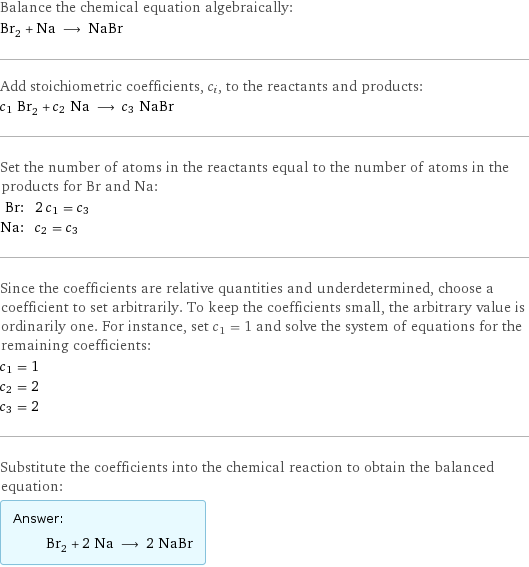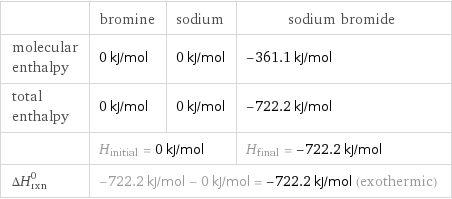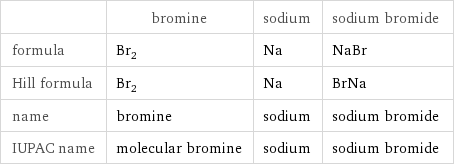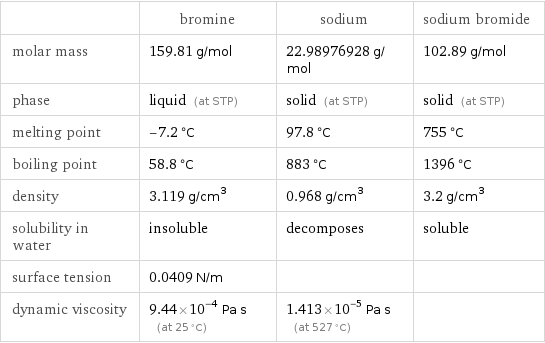Input interpretation

Br_2 (bromine) + Na (sodium) ⟶ NaBr (sodium bromide)
Balanced equation

Balance the chemical equation algebraically: Br_2 + Na ⟶ NaBr Add stoichiometric coefficients, c_i, to the reactants and products: c_1 Br_2 + c_2 Na ⟶ c_3 NaBr Set the number of atoms in the reactants equal to the number of atoms in the products for Br and Na: Br: | 2 c_1 = c_3 Na: | c_2 = c_3 Since the coefficients are relative quantities and underdetermined, choose a coefficient to set arbitrarily. To keep the coefficients small, the arbitrary value is ordinarily one. For instance, set c_1 = 1 and solve the system of equations for the remaining coefficients: c_1 = 1 c_2 = 2 c_3 = 2 Substitute the coefficients into the chemical reaction to obtain the balanced equation: Answer: | | Br_2 + 2 Na ⟶ 2 NaBr
Structures

+ ⟶
Names

bromine + sodium ⟶ sodium bromide
Reaction thermodynamics
Enthalpy

| bromine | sodium | sodium bromide molecular enthalpy | 0 kJ/mol | 0 kJ/mol | -361.1 kJ/mol total enthalpy | 0 kJ/mol | 0 kJ/mol | -722.2 kJ/mol | H_initial = 0 kJ/mol | | H_final = -722.2 kJ/mol ΔH_rxn^0 | -722.2 kJ/mol - 0 kJ/mol = -722.2 kJ/mol (exothermic) | |
Entropy

| bromine | sodium | sodium bromide molecular entropy | 152.2 J/(mol K) | 51 J/(mol K) | 84 J/(mol K) total entropy | 152.2 J/(mol K) | 102 J/(mol K) | 168 J/(mol K) | S_initial = 254.2 J/(mol K) | | S_final = 168 J/(mol K) ΔS_rxn^0 | 168 J/(mol K) - 254.2 J/(mol K) = -86.23 J/(mol K) (exoentropic) | |
Equilibrium constant
![Construct the equilibrium constant, K, expression for: Br_2 + Na ⟶ NaBr Plan: • Balance the chemical equation. • Determine the stoichiometric numbers. • Assemble the activity expression for each chemical species. • Use the activity expressions to build the equilibrium constant expression. Write the balanced chemical equation: Br_2 + 2 Na ⟶ 2 NaBr Assign stoichiometric numbers, ν_i, using the stoichiometric coefficients, c_i, from the balanced chemical equation in the following manner: ν_i = -c_i for reactants and ν_i = c_i for products: chemical species | c_i | ν_i Br_2 | 1 | -1 Na | 2 | -2 NaBr | 2 | 2 Assemble the activity expressions accounting for the state of matter and ν_i: chemical species | c_i | ν_i | activity expression Br_2 | 1 | -1 | ([Br2])^(-1) Na | 2 | -2 | ([Na])^(-2) NaBr | 2 | 2 | ([NaBr])^2 The equilibrium constant symbol in the concentration basis is: K_c Mulitply the activity expressions to arrive at the K_c expression: Answer: | | K_c = ([Br2])^(-1) ([Na])^(-2) ([NaBr])^2 = ([NaBr])^2/([Br2] ([Na])^2)](../image_source/32d50d84b59ef5f17a8c47fb3937ccda.png)
Construct the equilibrium constant, K, expression for: Br_2 + Na ⟶ NaBr Plan: • Balance the chemical equation. • Determine the stoichiometric numbers. • Assemble the activity expression for each chemical species. • Use the activity expressions to build the equilibrium constant expression. Write the balanced chemical equation: Br_2 + 2 Na ⟶ 2 NaBr Assign stoichiometric numbers, ν_i, using the stoichiometric coefficients, c_i, from the balanced chemical equation in the following manner: ν_i = -c_i for reactants and ν_i = c_i for products: chemical species | c_i | ν_i Br_2 | 1 | -1 Na | 2 | -2 NaBr | 2 | 2 Assemble the activity expressions accounting for the state of matter and ν_i: chemical species | c_i | ν_i | activity expression Br_2 | 1 | -1 | ([Br2])^(-1) Na | 2 | -2 | ([Na])^(-2) NaBr | 2 | 2 | ([NaBr])^2 The equilibrium constant symbol in the concentration basis is: K_c Mulitply the activity expressions to arrive at the K_c expression: Answer: | | K_c = ([Br2])^(-1) ([Na])^(-2) ([NaBr])^2 = ([NaBr])^2/([Br2] ([Na])^2)
Rate of reaction
![Construct the rate of reaction expression for: Br_2 + Na ⟶ NaBr Plan: • Balance the chemical equation. • Determine the stoichiometric numbers. • Assemble the rate term for each chemical species. • Write the rate of reaction expression. Write the balanced chemical equation: Br_2 + 2 Na ⟶ 2 NaBr Assign stoichiometric numbers, ν_i, using the stoichiometric coefficients, c_i, from the balanced chemical equation in the following manner: ν_i = -c_i for reactants and ν_i = c_i for products: chemical species | c_i | ν_i Br_2 | 1 | -1 Na | 2 | -2 NaBr | 2 | 2 The rate term for each chemical species, B_i, is 1/ν_i(Δ[B_i])/(Δt) where [B_i] is the amount concentration and t is time: chemical species | c_i | ν_i | rate term Br_2 | 1 | -1 | -(Δ[Br2])/(Δt) Na | 2 | -2 | -1/2 (Δ[Na])/(Δt) NaBr | 2 | 2 | 1/2 (Δ[NaBr])/(Δt) (for infinitesimal rate of change, replace Δ with d) Set the rate terms equal to each other to arrive at the rate expression: Answer: | | rate = -(Δ[Br2])/(Δt) = -1/2 (Δ[Na])/(Δt) = 1/2 (Δ[NaBr])/(Δt) (assuming constant volume and no accumulation of intermediates or side products)](../image_source/5bb22805bdceea4219c1f3ec32be3d2f.png)
Construct the rate of reaction expression for: Br_2 + Na ⟶ NaBr Plan: • Balance the chemical equation. • Determine the stoichiometric numbers. • Assemble the rate term for each chemical species. • Write the rate of reaction expression. Write the balanced chemical equation: Br_2 + 2 Na ⟶ 2 NaBr Assign stoichiometric numbers, ν_i, using the stoichiometric coefficients, c_i, from the balanced chemical equation in the following manner: ν_i = -c_i for reactants and ν_i = c_i for products: chemical species | c_i | ν_i Br_2 | 1 | -1 Na | 2 | -2 NaBr | 2 | 2 The rate term for each chemical species, B_i, is 1/ν_i(Δ[B_i])/(Δt) where [B_i] is the amount concentration and t is time: chemical species | c_i | ν_i | rate term Br_2 | 1 | -1 | -(Δ[Br2])/(Δt) Na | 2 | -2 | -1/2 (Δ[Na])/(Δt) NaBr | 2 | 2 | 1/2 (Δ[NaBr])/(Δt) (for infinitesimal rate of change, replace Δ with d) Set the rate terms equal to each other to arrive at the rate expression: Answer: | | rate = -(Δ[Br2])/(Δt) = -1/2 (Δ[Na])/(Δt) = 1/2 (Δ[NaBr])/(Δt) (assuming constant volume and no accumulation of intermediates or side products)
Chemical names and formulas

| bromine | sodium | sodium bromide formula | Br_2 | Na | NaBr Hill formula | Br_2 | Na | BrNa name | bromine | sodium | sodium bromide IUPAC name | molecular bromine | sodium | sodium bromide
Substance properties

| bromine | sodium | sodium bromide molar mass | 159.81 g/mol | 22.98976928 g/mol | 102.89 g/mol phase | liquid (at STP) | solid (at STP) | solid (at STP) melting point | -7.2 °C | 97.8 °C | 755 °C boiling point | 58.8 °C | 883 °C | 1396 °C density | 3.119 g/cm^3 | 0.968 g/cm^3 | 3.2 g/cm^3 solubility in water | insoluble | decomposes | soluble surface tension | 0.0409 N/m | | dynamic viscosity | 9.44×10^-4 Pa s (at 25 °C) | 1.413×10^-5 Pa s (at 527 °C) |
Units
